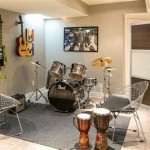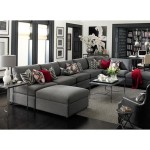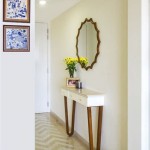How To Decorate a Rectangular Living Room
Rectangular living rooms are common, but their elongated shape can present decorating challenges. A well-planned design can transform this potentially awkward space into a stylish and functional area. This article offers practical advice on how to effectively decorate a rectangular living room.
Defining Zones: One of the most effective strategies for managing a rectangular living room is to divide it into distinct zones. This breaks up the length and creates separate areas for different activities. Common zones include a seating area for conversation, a media area for watching television, and a reading nook.
Furniture Placement for Defined Zones: Once zones are defined, furniture placement becomes key. The largest pieces, such as sofas, should anchor the primary seating area. Consider using an L-shaped sofa or a combination of a sofa and loveseat to define this space. In the media area, position furniture towards the television, ensuring comfortable viewing angles. A smaller armchair and a side table can create a cozy reading nook.
Using Rugs to Delineate Zones: Rugs are invaluable tools for visually separating zones within a rectangular living room. Place a rug within each designated area, ensuring the rug is large enough to encompass the furniture within that zone. This creates a sense of cohesion within each area and distinguishes it from the others. Choose rugs that complement each other in style and color palette to maintain a harmonious overall aesthetic.
Balancing Length with Visual Width: The objective is to mitigate the elongated feel of the room. One effective technique is to create visual width. This can be achieved by placing furniture perpendicular to the longer walls. For instance, positioning a sofa or a console table against the shorter walls draws the eye outwards, creating a sense of balance.
Selecting the Right Furniture Scale: Avoid overcrowding the space with oversized furniture. Instead, opt for pieces proportionate to the room's dimensions. Sleek, streamlined furniture will enhance the sense of space, while bulky items can make the room feel cramped and cluttered. Measure the room and furniture carefully before making any purchases to ensure a proper fit.
The Role of Lighting in a Rectangular Room: Lighting plays a crucial role in shaping the ambiance and functionality of a rectangular living room. Utilize a combination of lighting types: ambient lighting for overall illumination, task lighting for specific activities like reading, and accent lighting to highlight architectural features or artwork. Layered lighting creates depth and visual interest.
Addressing Traffic Flow: Consider the pathways of movement through the room. Ensure adequate space for comfortable circulation between zones. Avoid placing furniture in a way that obstructs walkways or creates bottlenecks. Maintaining clear pathways contributes to a functional and welcoming environment.
Wall Decor Strategies: Strategically placed wall decor can also contribute to a balanced aesthetic. Consider using large-scale artwork or mirrors on the shorter walls. This draws the eye outward and creates a sense of spaciousness. Gallery walls, composed of smaller pieces, can add visual interest without overwhelming the space.
Window Treatments for Rectangular Rooms: Window treatments are essential for controlling light and privacy. In a long room, consider using curtains or drapes that hang from ceiling to floor. This visually elongates the walls and adds a touch of elegance. Choose fabrics and colors that complement the overall decor scheme.
Color Palette Considerations: Lighter colors generally make a room feel more spacious, while darker colors can create a sense of intimacy. Consider using lighter hues on the walls and incorporating pops of color through accessories and furnishings. A cohesive color palette throughout the room will create a unified look and feel.
Focal Point Creation: Establish a focal point to anchor the room visually. This can be a fireplace, a large piece of artwork, or a striking piece of furniture. Positioning furniture around the focal point creates a natural gathering area and helps to balance the room's proportions.
Incorporating Vertical Space: Don't neglect the vertical space. Tall bookshelves, floor-to-ceiling curtains, and strategically placed artwork draw the eye upwards, adding visual height to the room and counteracting the horizontal emphasis. This can be particularly effective in rooms with lower ceilings.
The Importance of Decluttering: Maintaining a clutter-free environment is essential in a rectangular living room. Clutter can exacerbate the sense of narrowness. Regularly declutter surfaces, shelves, and storage areas to maintain a clean and organized space. Adequate storage solutions are crucial for keeping belongings out of sight.
Accessorizing for Visual Interest: Accessories add personality and style to a living room. Use cushions, throws, decorative objects, and plants to add color, texture, and visual interest. However, avoid overcrowding the space with too many accessories. A few carefully chosen pieces will have a greater impact than a cluttered collection.

Top Tips On How To Design Your Rectangular Living Room The House

How To Arrange Furniture In A Rectangular Living Room Setting For Four Interiors

How To Arrange Furniture In A Rectangular Living Room Design Cafe

Top Tips On How To Design Your Rectangular Living Room The House

How To Arrange Furniture In A Rectangular Living Room Design Cafe

How To Arrange Furniture In A Rectangular Living Room Design Cafe

29 Best Rectangular Living Rooms Ideas Room Designs Livingroom Layout

How To Arrange Furniture In A Rectangular Living Room Design Cafe

Decorating A Long Narrow Family Room

How To Arrange Furniture In A Long Narrow Living Room Solutions For Tricky Spaces
Related Posts







